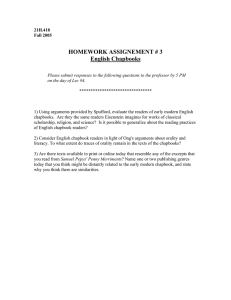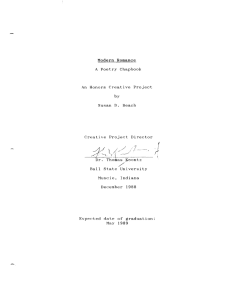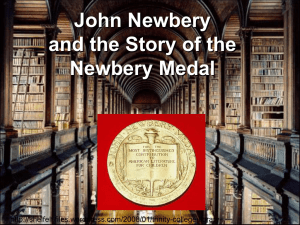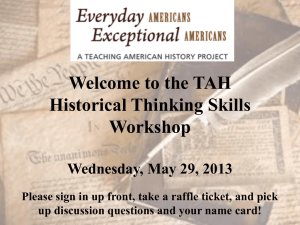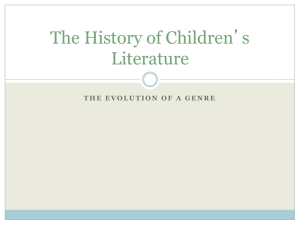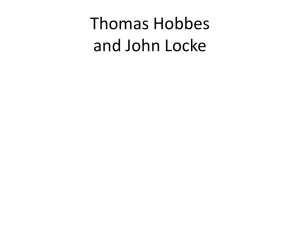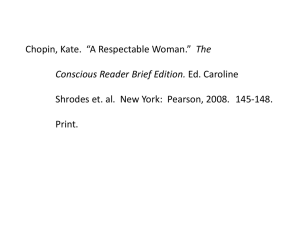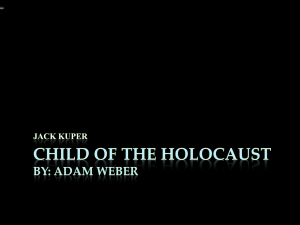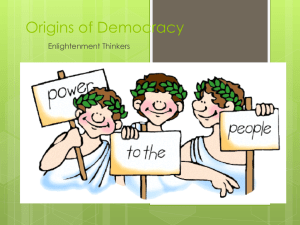Powerpoint slide show
advertisement
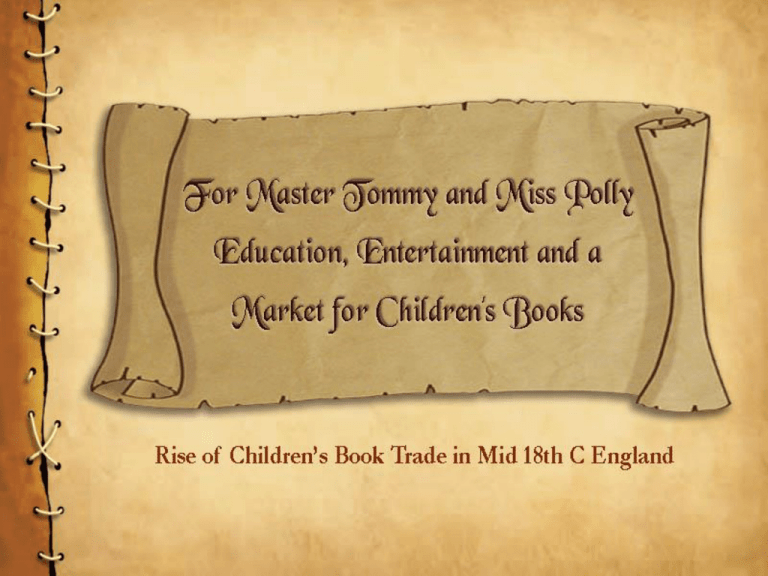
Number of books known to be published for children or read by them: 1621 to 1740 – 17 entries 1741 to 1800 – 135 entries Source: Be Merry and Wise: Origins of Children’s Book Publishing In England, 1650-1850 • Social Developments leading to a‘Market’ for Children’s books • Lockean Ideology: John Newbery and His Successors • The Popular Market: Chapbooks and Forbidden Lore • The Ideological versus the Popular: New Tendencies in Children’s Books Social and economic factors conducive to the rise of a ‘book market’ for children in mid 18th C England 1. Increase in the child population 2. Rapid growth in educational provisions and hence, a rise in the literacy levels 3. Commercial prosperity and social mobility following a larger middle-class social sector, more people could afford books and education than before 4. Reading developed as a pastime; books were not only sources of education but were increasingly looked upon as a way of spending leisure John Locke and the subject of educating the child Essay Concerning Human Understanding (1690) Some Thoughts Concerning Education (1693) I have always had a fancy that learning might be made a play and recreation to children: and that they might be brought to desire to be taught, if it were proposed to them as a thing of honour, credit, delight, and recreation, or as a reward for doing something else; and if they were never chid or corrected for the neglect of it. Thus children may be cozen’d into a knowledge of the letters; be taught to read, without perceiving it to be any thing but a sport, and play themselves into that which others are whipp’d for. When by these gentle ways he begins to read, some easy pleasant book, suited to his capacity, should be put into his hands, wherein the entertainment that he finds might draw him on, and reward his pains in reading…. To this purpose, I think Æsop’s Fables the best, which being stories apt to delight and entertain a child…. If his Æsop has pictures in it, it will entertain him much the better, and encourage him to read Teach him to get a mastery over his inclinations, and submit his appetite to reason. •disciplining the mind through rational judgement •distrust of imagination •instruction through diversion The History of Little Goody Two-shoes (1765) Who from a state of rags and care And having shoes but half a pair Their fortune and their fame would fix And gallop in a coach of six They take all kinds of names and forms: almanacks for children, newspapers for children, journals for children, stories for children, comedies for children, dramas for children, geography for children history for children physics for children, logic for children, catechisms for children, travels for children, morals for children, grammars for children and reading books in all languages…poetry, sermon, letters, talks for children and unlimited variation on the same theme, so that the literary doll-shops are crammed all year round with them… (A German Schoolmaster writing in 1787, source – Muir Percy , English Children’s Books) Newbery’s advertisement for a new book Nurse Truelove’s New Year’s Gift or the Book of Books for Children, adorned with cuts and designed as a Present for every little Boy who would become a great Man and ride upon a fine Horse, and to every little Girl who would become a great Woman and ride in a Lord Mayor’s gilt Coach. Printed for the Author who has ordered these books to be given gratis to all little Boys at the Bible and the Sun in St Paul’s Churchyard, they paying for the binding which is only Twopence each Book. At Harris’ St Paul’s Churchyard Good children meet a sure reward In coming home the other day I heard a little master say For ev’ry threepence there he took He had received a little book With covers neat and cuts so pretty Theres not its like in all the City And that for threepence he could buy A story book would make one cry For a little more a book of riddles Then let us not buy drums or fiddles Nor yet be stopt at pastry-cooks But spend our money all in books For when we have learnt each book by heart Mama will treat us with a tart. Advertisement by John Harris (London) and Joseph Johnson (Philadelphia) Newbery’s books and those of his successors, were aimed at the middle class of young citizens, for the ‘young gentlemen and ladies’ Mary Cooper’s Tommy Thumb’s Song Book for all the little Masters and Misses: to be sung to them by their Nurses till they can sing them themselves. By Nurse Lovechild’ (advertised in London Evening Post, March 1744) Nurse Truelove’s Christmas Box (1760) Nurse Truelove’s New Year’s Gift (1760) Twelfth Day Gift (1767) Whitsuntide Gift (1767) Banishment of the ‘faerie realm’ “feigned fables, vain fantasies, wanton stories and songs of love” • to the Puritans they were ungodly and untrue, • to Locke and the Age of Reason they were irrational and dangerous, (Fairy and fairy-lore, goblins and spirits with other superstitions Locke regarded as ‘useless trumpery’) • to Rousseau and the moralists they were utterly useless. • Chapbooks were inexpensive publications designed for the poorer literate classes • Hawked by itinerant pedlars or ‘chapmen’ in remote parts of the country where there were no bookshops • the chapbooks had to be brief, without refinements of book production, roughly printed on coarsest and cheapest paper, without wrapper or cover of any sort and an entire book printed on a single sheet, folded to make eight, sixteen, or twenty-four pages History of the Seven Champions of Christendom The Children in the Wood The Most Excellent and Delightful History of Guy Earl of Warwick The Life and Death of Fair Rosamond, Concubine to King Henry the Second... The Story of the Cruel Bluebeard and His Many Wives A True Tale of Robin Hood The Adventures of Robinson Crusoe Adventures of Captain Gulliver History of Jack the Giant Killer James Boswell noted in 1763: ‘Having when a boy, been much entertained with Jack the Giant-Killer and such little Store Books, I have always retained a kind affection for them…’ John Clare, born in 1793, describes in his autobiography what such reading material meant to a child growing up in a poor, rural home, with a barely literate father who ‘was very fond of superstitious tales that are hawked about the streets for a penny’…. gleaned from the ‘sixpenny Romances’ like Cinderella, Little Red Riding Hood or Jack and the Beanstalk. Wordsworth, The Prelude(V, 364-9, 1805-6 version) Oh, give us once again the wishing-cap Of Fortunatus, and the invisible coat Of Jack the Giant-killer, Robin Hood, And Sabra in the forest with St George! Encompassing witchcraft, superstition, street cries, dragons, ogres, fairies and every kind of magic shunned by the age of reason, for many generations the chapbooks gave children a wide range of easily digestible reading matter that could not be found elsewhere. The Most Excellent History of Argalus and Parthenia Simple Simon's Misfortunes : and His Wife, Margery's Outragious Cruelty Impact of the ‘respectable’ and the ‘popular’ books giving rise to new tendencies in the children’s book market ‘Respectable’ Market • mood grows more lighthearted • fairy tales are printed officially for children ‘chapbook content’ explored and ‘chapbook format’ imitated by several respectable publishers (Elizabeth Newbery’s 1800 catalogue contained thirteen penny and fourteen two penny items, James Lumsden & Son of Glasgow had at least twenty-seven of these) Chapbook Market • chapbooks for children : better quality of print and cuts, contents designed to suit child readers • Coloured wappers and volume numbers creating a ‘series’ to be collected like ‘Juvenile Library’ or ‘Juvenile Books’ Whittington and His Cat Mrs. Lovechild's Golden Present, for all Good Little Boys and Girls Secondary Sources 1.Pickering, Samuel F. John Locke and Children’s Books in Eighteenth Century England 2. Townsend, John Rowe. Written for Children 3. Hunt, Peter (ed). Children’s Literature: An Illustrated History 4. Muir, Percy. English Children’s Books 5. Alderson, Brian and Felix De Marez Oyens. Be Merry and Wise: Origins of Children’s Book Publishing In England, 1650-1850 The Chapbook facsimiles used have been accessed online from the Edith Nesbit Chapbook Collection at http://www.library.pitt.edu/libraries/is/enroom/index.html Thank You
